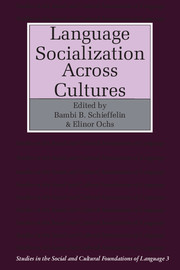Book contents
- Frontmatter
- Contents
- List of contributors
- 1 Introduction
- Part I Acquiring language and culture through interactional routines
- 2 Calling-out and repeating routines in Kwara'ae children's language socialization
- 3 Prompting routines in the language socialization of Basotho children
- 4 Interactional routines as cultural influences upon language acquisition
- 5 What no bedtime story means: narrative skills at home and school
- Part II Acquiring knowledge of status and role through language use
- Part III Expressing affect: input and acquisition
- Index
5 - What no bedtime story means: narrative skills at home and school
Published online by Cambridge University Press: 05 June 2012
- Frontmatter
- Contents
- List of contributors
- 1 Introduction
- Part I Acquiring language and culture through interactional routines
- 2 Calling-out and repeating routines in Kwara'ae children's language socialization
- 3 Prompting routines in the language socialization of Basotho children
- 4 Interactional routines as cultural influences upon language acquisition
- 5 What no bedtime story means: narrative skills at home and school
- Part II Acquiring knowledge of status and role through language use
- Part III Expressing affect: input and acquisition
- Index
Summary
In the preface to Introduction to S/Z, Roland Barthes's work on ways in which readers read, Richard Howard writes: “We require an education in literature … in order to discover that what we have assumed – with the complicity of our teachers – was nature is in fact culture, that what was given is no more than a way of taking” (emphasis not in the original; Howard 1974:ix). This statement reminds us that the culture children learn as they grow up is, in fact, “ways of taking” meaning from the environment around them. The means of making sense from books and relating their contents to knowledge about the real world is but one “way of taking” that is often interpreted as “natural” rather than learned. The quote also reminds us that teachers (and researchers alike) have not recognized that ways of taking from books are as much a part of learned behavior as are ways of eating, sitting, playing games, and building houses.
As school-oriented parents and their children interact in the preschool years, adults give their children, through modeling and specific instruction, ways of taking from books that seem natural in school and in numerous institutional settings such as banks, post offices, businesses, and government offices. These mainstream ways exist in societies around the world that rely on formal educational systems to prepare children for participation in settings involving literacy.
- Type
- Chapter
- Information
- Language Socialization across Cultures , pp. 97 - 124Publisher: Cambridge University PressPrint publication year: 1987
- 8
- Cited by



